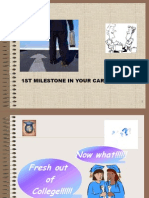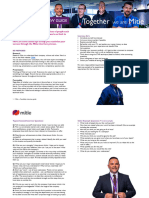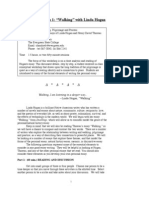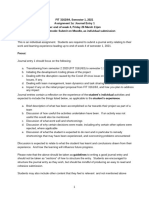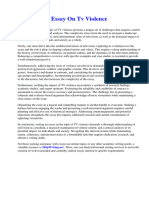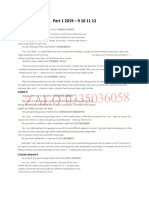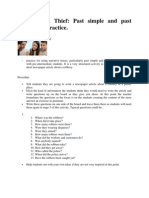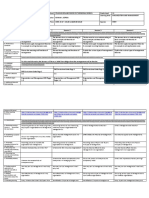MASTERING
THE INTERVIEW PROCESS
A COMPREHENSIVE GUIDE FOR APPLICANTS
Jenna Matthews
� I. Introduction
01
� I. Introduction
A. Importance of interview preparation for job seekers
Stand out from the competition: In today's competitive job market, candidates need to be well-
prepared to differentiate themselves from other applicants.
Showcase the best version of yourself: A well-prepared interviewee can effectively demonstrate
their strengths, skills, and experiences to potential employers.
Make a lasting impression: First impressions are crucial, and thorough preparation can ensure that
you leave a positive impact on the interviewer.
Alleviate anxiety and boost confidence: Familiarizing yourself with the interview process, potential
questions, and company information can help reduce nervousness and increase self-assurance.
Improve overall interview performance: Proper preparation leads to better communication, stronger
answers, and more engaging discussions, ultimately increasing the chances of a successful interview.
02
� Objective
Equip applicants with effective strategies to excel in interviews
Provide actionable tips and Empower applicants with Encourage continuous Foster career growth and
techniques knowledge improvement development
This presentation aims to provide By understanding the interview The presentation seeks to inspire By mastering interview
candidates with practical advice process and what interviewers applicants to continually refine techniques, job seekers can
on how to navigate various are looking for, candidates can their interview skills, learn from enhance their career prospects,
aspects of the interview process, approach interviews with each experience, and adapt their obtain desirable positions, and
from research and preparation to greater confidence and a higher strategies to different situations achieve long-term professional
answering questions and post- likelihood of success. and companies. growth.
interview etiquette.
03
� II. Pre-Interview Preparation
04
� A. Research the company and industry
1. Company values and culture
Visit the company's website: Utilize social media Explore employee reviews
Review the "About Us" section, mission Follow the company's social media Browse websites like Glassdoor to read
statement, and core values to gain insight accounts for updates on events, feedback from current and former
into the organization's culture. achievements, and employee experiences. employees about the work environment.
2. Current news and projects
Review press releases Analyze competitors Identify industry challenges
Check the company's website or search Research similar organizations to Gain insight into the unique obstacles and
for recent news articles to stay informed understand the industry landscape and opportunities within the sector to
about the latest projects, partnerships, or trends. demonstrate informed enthusiasm during
industry developments. the interview.
05
� B. Understand the job description and requirements
Analyze key responsibilities Identify required skills and Clarify any uncertainties
Carefully read the job description to qualifications If needed, reach out to the hiring
identify essential duties and tasks for the Determine the necessary technical manager or recruiter for clarification on
position. and soft skills listed, such as experience, specific aspects of the role.
education, certifications, and interpersonal
abilities.
C. Tailor your resume and cover letter for the specific role
Customize your resume Write a targeted cover letter Use keywords from the job
Emphasize relevant experience, Explain your interest in the position and description
accomplishments, and skills that directly company, and showcase how your Incorporate terminology from the job
align with the job requirements. background makes you an ideal candidate. posting to increase the chances of being
noticed by applicant tracking systems.
03
06
� D. Plan your attire and logistics
1. Dress appropriately for the company culture
Research dress code: Investigate the organization's dress code,
whether it's formal, business casual, or casual.
Choose professional attire: Select clean, well-fitting clothes that
reflect the company's culture and make you feel confident.
Groom appropriately: Ensure your hair, nails, and overall
appearance are neat and polished.
07
� D. Plan your attire and logistics
2. Ensure transportation and punctuality
Plan your route: Determine the best way to reach the interview location,
accounting for potential traffic or public transportation delays..
Do a test run: If possible, visit the interview location beforehand to
familiarize yourself with the route and parking options.
Arrive early: Aim to arrive 10-15 minutes before your scheduled
interview time to account for any unexpected obstacles and to make a
punctual first impression.
08
� III. Common Interview Questions
and How to Answer Them
09
� III. Common Interview Questions and How to Answer Them
A. "Tell me about yourself" B. "Why are you interested in this role?"
1. Create a concise and compelling narrative 1. Show enthusiasm for the company
Provide a brief overview of your professional background, Express genuine interest in the organization's values, culture,
focusing on experiences and skills relevant to the role.. and projects, drawing on your research.
2. Highlight key accomplishments 2. Emphasize relevant skills and experiences
Mention notable achievements or milestones that demonstrate Discuss how your qualifications align with the job requirements
your expertise and value as a candidate. and make you a strong fit for the role.
3. Connect your experience to the job 3. Explain the potential for growth and development
Explain how your background has prepared you for the position Describe how the position aligns with your career goals and
and how it aligns with your career goals. offers opportunities for personal and professional growth.
10
� III. Common Interview Questions and How to Answer Them
C. "What are your strengths and weaknesses?" D. "How do you handle conflicts or challenging situations?"
1. Highlight strengths relevant to the job 1. Use the STAR method
Focus on your most valuable skills and experiences that Describe a specific Situation, the Task at hand, the Action you
directly relate to the position. took, and the Result that followed.
2. Discuss weaknesses with a growth mindset 2. Showcase your problem-solving skills
Choose a genuine weakness and explain the steps you have Explain your thought process and approach to resolving conflicts
taken or are taking to address it and improve. or overcoming challenges.
3. Demonstrate self-awareness 3. Highlight interpersonal skills
Show that you are aware of your strengths and areas for Emphasize your ability to communicate effectively, collaborate
improvement and are committed to personal growth. with others, and maintain a positive attitude in difficult situations.
11
� III. Common Interview Questions and How to Answer Them
F. Tailoring your answers using the STAR method
E. "Why should we hire you?"
(Situation, Task, Action, Result)
1. Summarize your qualifications
1. Situation
Briefly reiterate your most relevant skills, experiences, and
Provide context by describing the circumstances or setting of
accomplishments.
the example you are discussing.
2. Demonstrate your unique value
2. Task
Explain how your specific background, perspective, or skills
Explain your role or responsibility within the situation, including
make you stand out from other candidates.
any objectives or goals you were trying to achieve.
3. Connect to the company's needs
3. Action
Describe how your strengths align with the organization’s
Detail the specific steps or actions you took to address the
goals and how you can contribute to the company's success.
task or challenge at hand.
4. Result
Describe the outcome or impact of your actions, emphasizing
any successes, lessons learned, or positive outcomes.
12
� IV. Behavioral and Technical
Interview Tips
13
� A. Showcasing relevant skills B. Demonstrating problem-
and experiences solving abilities
1. Prepare examples in advance 1. Share specific examples
Identify instances from your past experiences that Discuss situations where you have successfully
highlight your skills and qualifications relevant to identified, analyzed, and resolved problems or
the job. challenges.
2. Use the STAR method 2. Highlight your thought process
Structure your examples using the Situation, Task, Explain the steps you took to approach the
Action, and Result format to provide a clear and problem, including any research, brainstorming,
concise narrative. or analysis you performed.
3. Emphasize the connection 3. Emphasize results and lessons learned
Explicitly link your skills and experiences to the job Describe the outcomes of your problem-solving
requirements, demonstrating how you can efforts, focusing on the positive impact and any
contribute to the organization. valuable insights gained.
14
� C. Providing examples of D. Exhibiting adaptability
teamwork and collaboration and resilience
1. Discuss team projects 1. Share experiences of change or adversity
Share instances where you have worked Discuss situations where you have faced
effectively with others, whether in a professional, unexpected changes or challenges and how you
academic, or volunteer setting. responded to them.
2. Highlight your role
Explain your specific contributions to the team's 2. Demonstrate flexibility and resourcefulness
success, such as leading, organizing, or supporting Explain how you adapted your approach or
your teammates. found creative solutions to overcome obstacles.
3. Showcase interpersonal skills 3. Highlight personal growth
Emphasize your ability to communicate, listen, Describe the lessons learned from these
and compromise with others to achieve a experiences and how they have contributed to
common goal. your development and resilience.
15
� V. Non-Verbal Communication
and Body Language
16
� A. Maintaining eye contact
1. Establish rapport: Make eye contact with the interviewer to demonstrate
attentiveness and create a connection.
2. Balance engagement and comfort: Maintain a natural level of eye contact
without staring or avoiding the interviewer's gaze.
3. Redirect eye contact when needed: When multiple interviewers are
present, ensure you establish eye contact with each person as you speak
and listen.
B. Exhibiting confident posture
1. Sit up straight: Maintain an upright and relaxed posture to project
confidence and attentiveness.
2. Keep your feet grounded: Place your feet flat on the floor and avoid
crossing your legs or fidgeting to convey stability and composure.
3. Lean in slightly: Lean in subtly when listening or speaking to show interest
and engagement in the conversation.
17
� C. Using appropriate hand gestures
1. Emphasize key points: Use hand gestures to reinforce important points,
such as counting on your fingers or gesturing to show size or direction..
2. Avoid excessive or distracting movements: Keep gestures purposeful and
controlled, refraining from overusing them or making erratic motions.
3. Be mindful of cultural differences: Research cultural norms and customs
regarding body language and gestures to ensure your non-verbal
communication is appropriate and respectful.
D. Monitoring your tone and pace of speech
1. Speak clearly and confidently: Use a steady, audible volume and
enunciate your words to ensure your message is understood.
2. Adjust your pace: Speak at a comfortable pace, neither too fast nor too
slow, allowing the interviewer to follow and process your responses.
3. Convey enthusiasm and sincerity: Use variations in tone and pitch to
express excitement, interest, and genuine emotion during the conversation.
18
� VI. Asking Thoughtful Questions
19
� A. Preparing questions about the role and company
Explore future projects or
Seek clarification initiatives Discuss team dynamics
Ask for more information about any Inquire about upcoming projects, goals, Ask about the team structure,
aspects of the job description or or challenges the team or company will collaboration, and communication
responsibilities that may be unclear. be facing. processes within the organization.
B. Inquiring about growth and development opportunities
Ask about training programs Explore career progression Discuss performance evaluation
Learn about any onboarding, mentorship, Inquire about potential career paths Ask about the performance review
or professional development programs within the organization and process and how the company sets
the company offers. how the company supports employee expectations and provides feedback.
growth.
03
20
� C. Asking about company culture and values
Explore the work environment Discuss company values Learn about employee satisfaction
Inquire about the day-to-day work Ask how the company's values are Inquire about the company's efforts to
atmosphere, team dynamics, and reflected in its policies, decision-making, maintain a positive work environment,
leadership style within the organization. and employee engagement. address employee concerns, and foster
work-life balance.
D. Avoiding questions about salary and benefits (initially)
Focus on fit and value Wait for the appropriate time Be prepared with research
Prioritize questions about the role, Save discussions about salary and If the topic arises, ensure you have
company, and growth opportunities to benefits for later stages of the interview conducted market research on industry
demonstrate your genuine interest and process or when prompted by the salary norms and have a clear
enthusiasm for the position. interviewer. understanding of your worth and
expectations.
21
� VII. Handling Challenging Interview
Situations
22
� A. Addressing employment gaps or job changes
1. Be honest and concise: Provide a straightforward explanation for any
employment gaps or job changes without going into excessive detail.
2. Focus on personal growth: Emphasize the productive activities you
engaged in during the gaps, such as volunteering, professional
development, or education.
3. Highlight transferable skills: Discuss the skills and experiences you
gained in previous roles that are relevant and valuable for the position you
are applying for.
B. Discussing lack of experience or skills
1. Emphasize your strengths: Focus on the skills and qualifications you
possess that make you a strong candidate for the role.
2. Demonstrate adaptability and willingness to learn: Show that you are
open to new challenges and have a track record of learning and adapting
quickly in different situations.
3. Leverage relevant experiences: Draw on any related experiences, such as
academic projects, internships, or volunteer work, to showcase your
potential and capability to perform in the role.
23
� C. Dealing with illegal or inappropriate questions
1. Recognize your rights: Be aware of the legal protections in place that
prohibit discriminatory questions related to age, gender, race, religion,
marital status, and other protected categories.
2. Politely deflect or redirect: If faced with an inappropriate question, you
can choose to politely decline to answer or redirect the conversation to a
relevant topic.
3. Assess the situation: Consider the interviewer's intent and whether the
question was a genuine mistake or indicative of a larger issue with the
company's culture..
D. Staying calm and composed under pressure
1. Practice relaxation techniques: Use deep breathing, visualization, or
mindfulness exercises to help manage stress and anxiety during the
interview.
2. Take a moment to think: If faced with a difficult question, pause briefly to
gather your thoughts and formulate a thoughtful response.
3. Maintain a positive attitude: Stay focused on your strengths, qualifications,
and interest in the role, and remember that it's normal to feel nervous
during an interview.
24
� VIII. Post-Interview Etiquette
25
� A. Sending a thank-you note to the interviewer(s)
Timing Personalization Restate your interest
Send a thank-you note within 24 hours of Address the interviewer(s) by name and Briefly reiterate your enthusiasm for the
the interview to express your include specific details from the role and your confidence in your ability to
appreciation and reinforce your interest in conversation to make the note more contribute to the organization.
the position. genuine and memorable.
B. Following up on the hiring process
Respect the timeline Be professional and polite Maintain a balance
If the interviewer provided a timeline for When following up, send a concise and Show your interest in the position without
the hiring process, wait until that courteous email or make a phone call to appearing overly persistent or impatient.
timeframe has passed before following inquire about the status of your Follow up once or twice at most, and respect
up. application. the employer's decision-making process.
26
� C. Reflecting on your interview performance
Review your answers Evaluate your non-verbal Analyze the interviewer's reactions
Assess the effectiveness of your communication Take note of any feedback, both verbal and
responses and consider how you could Consider your body language, eye contact, non-verbal, you received during the
improve or refine them for future and tone of voice during the interview and interview to help gauge your performance
interviews. identify any areas for improvement. and areas for growth.
D. Seeking feedback and opportunities for improvement
Request feedback Learn from rejection Continue developing your skills
If you did not receive an offer, consider Use rejection as a learning experience to Pursue professional development
politely asking the interviewer for help you better understand your opportunities, such as workshops, courses, or
feedback on your performance and how strengths and weaknesses and prepare mentorship programs, to improve your skills
you could improve in the future. for future interviews. and enhance your candidacy for future job
applications.
27
� IX. Conclusion
A. Recap of main points
Pre-interview preparation: Research the company and industry, Asking thoughtful questions: Prepare meaningful inquiries about
01 tailor your resume, and plan logistics.
05 the role, company, growth opportunities, and culture.
Common interview questions: Understand how to effectively Handling challenging situations: Address employment gaps, lack
02 answer frequently asked questions using the STAR method..
06 of experience, inappropriate questions, and maintain composure.
Behavioral and technical tips: Showcase relevant skills, problem- Post-interview etiquette: Send thank-you notes, follow up
03 solving abilities, teamwork, and adaptability.
07 professionally, reflect on performance, and seek feedback.
Non-verbal communication: Focus on maintaining eye contact,
04 confident posture, appropriate hand gestures, and controlled speech.
28



















